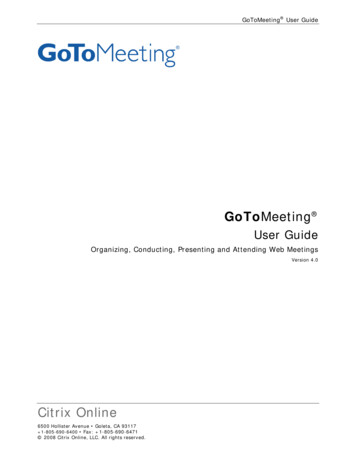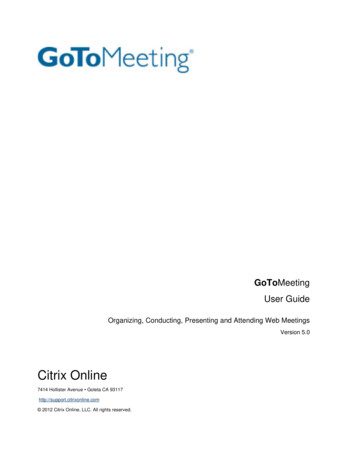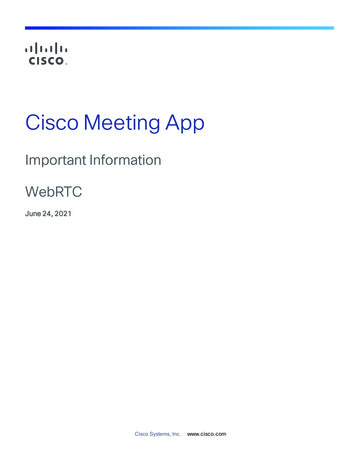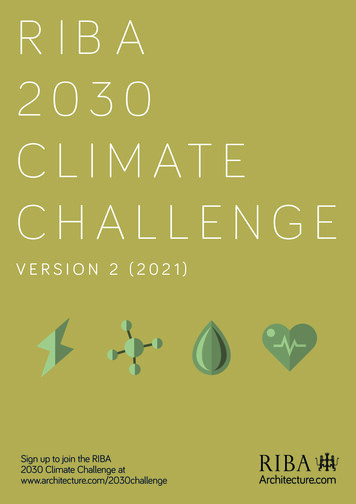
Transcription
Meeting theClimate ChallengeA Carbon Fee Should Be the Centerpieceof America’s Climate StrategyBy: Greg Bertelsen and Catrina RorkeForeword by Christine Todd Whitman
Forewordby Christine Todd WhitmanThe United States has a window of opportunityto act decisively on climate and ensure a livableplanet for future generations. The internationalcommunity has set a goal of achieving net-zeroemissions by midcentury. For the U.S. to meetthis enormously challenging target, we mustembrace a strategy that can achieve fast andmeasurable progress.A carbon fee at the heart of a U.S. climatestrategy will go further, faster than any othersingle policy intervention.There is no better tool available for rapidlydecarbonizing than an economy-wide feeon carbon. A carbon fee at the heart of aU.S. climate strategy will go further, fasterthan any other single policy intervention. It canbe designed to guarantee emissions reductions.It clears the path for innovators. It can reachbeyond American shores to encourage greaterclimate ambition globally. And it acts as amultiplier for climate progress when paired witheverything else we’re doing to lower emissions.If you want to stimulate clean-tech innovation,a carbon price provides a powerful incentivecoupled with market certainty to entrepreneurs.If you want to promote electric vehicles, a carbonprice stokes consumer demand. If you want toexpand direct air capture, you can entice marketentrants with a carbon price. And if you want toaccelerate a fast transition to clean power, puta price on carbon. No matter what the specificpolicy goal, a carbon price amplifies its impact.A carbon fee harnesses market forces and the fullinnovative power of the private sector towarda clean energy future. It touches virtually everydecision in the economy, steering all businessesand consumers toward low-carbon solutions.Where no solutions exist, it offers the marketcertainty and economic incentives for innovatorsto develop and deploy them. As this studydescribes, a carbon fee of 40 per ton (2017 ),if implemented in 2023, can cut U.S. emissionsin half by 2035. Paired with other commonlydiscussed policies and investments, this carbonprice would be consistent with an emissionsreduction target of 50% or more below 2005levels by the year 2030.A carbon fee also works remarkably fast. Evenbefore it is implemented, consumers andbusinesses will anticipate energy price changesand begin shifting their behavior. Once the feegoes into effect, low-carbon solutions will quickly
find their place in the market in every corner ofthe economy.Speed is of the essence for climate policy: thefaster we cut emissions, the more we slow climatechange and prevent damage to natural ecosystemsand human health. At the same time, a policythat works quickly will strengthen America’s handin global negotiations: soon after announcingclimate commitments, the U.S. will have theemissions reductions to back them up.As good as it is at cutting domestic emissions,a carbon fee doesn’t just work at home. Coupledwith a system of border carbon adjustments,it is the only climate tool that increases U.S.ambition while reaching beyond our borders toprice the emissions of imported goods. Overseasmanufacturers will face a choice: lower theiremissions or lose a piece of the world’s largestmarket. By leveraging the power of the U.S.consumer, America can give a much-neededjolt to global climate efforts, encouragingother countries to switch to clean energy.While its primary purpose is to combat climatechange, a carbon fee can also speed progresson other major environmental problems, likeimproving the air quality in our communities. Ascarbon emissions plummet, so will air pollutantsthat are associated with burning fossil fuels. Acarbon fee can cut other pollutants by as muchas half across the economy, cleaning upcommunities as we protect the climate. In thisway, a carbon fee can act as a complement toother necessary policies and regulations to ensurethe health and safety of all communities.By leveraging the power of the U.S. consumer,America can give a much-needed joltto global climate efforts, encouraging othercountries to switch to clean energy.For all these reasons, a carbon fee should serveas the centerpiece of a U.S. strategy to achievenet zero emissions. While it won’t get us all theway there, it will go further than any other singlepolicy toward that goal.Christine Todd Whitman served as Administrator of the Environmental Protection Agencyfrom 2001 to 2003 under President George W. Bush. From 1994 to 2001, she was the50th governor of New Jersey.
About the AuthorsGreg Bertelsen is CEO of the ClimateLeadership Council. Previously,Mr. Bertelsen served as Senior Director ofEnergy and Resources Policy at the NationalAssociation of Manufacturers (NAM).Catrina Rorke is Vice Presidentof Policy at the Climate Leadership Council.Previously, Ms. Rorke served as Directorof Energy Policy at the R Street Institutewhere she founded the institute’s energy andenvironment program.Meeting the Climate ChallengeExecutive Summary . . . . . . . . . . . . . . . . . . . . . . . . . . . . . . . . . . . . . . . . . . . . . . . . . . . . . . . . . . .1I. Ambitious Domestic Emissions Reductions . . . . . . . . . . . . . . . . . . . . . . . . . . . . . . . . . . .2II. Emissions Drop Quickly . . . . . . . . . . . . . . . . . . . . . . . . . . . . . . . . . . . . . . . . . . . . . . . . . . . . . 3III. Safeguarding Emission Cuts . . . . . . . . . . . . . . . . . . . . . . . . . . . . . . . . . . . . . . . . . . . . . . . . 4IV. Global Impacts: Raising the U.S. Profile . . . . . . . . . . . . . . . . . . . . . . . . . . . . . . . . . . . . . . 4V. Global Impacts: Leveraging a Clean U.S. Economy . . . . . . . . . . . . . . . . . . . . . . . . . . . . 5VI. Domestic Public Health Benefits . . . . . . . . . . . . . . . . . . . . . . . . . . . . . . . . . . . . . . . . . . . . . 7VII. Conclusion: Leveraging a Force Multiplier . . . . . . . . . . . . . . . . . . . . . . . . . . . . . . . . . . . . 7About the Climate Leadership CouncilThe Climate Leadership Council is an international research and advocacy organization founded incollaboration with a who’s who of business, opinion and environmental leaders to promote a carbondividends framework as the most cost-effective, equitable and politically-viable climate solution.Find out more at www.clcouncil.org.
Executive SummaryThe risks to human and economic health continueto mount as we further delay taking comprehensiveactions to address climate change. The U.S. mustreassert its role as a climate leader with anambitious domestic policy to support rapid,economy-wide decarbonization. This is essentialfor jumpstarting international cooperation towardmeaningful global emissions reductions. A risingcarbon fee and border carbon adjustment as acentral piece of U.S. climate policy will: cut carbon emissions reductions furtherand faster than other measures; reduce emissions of other airpollutants that are impactinglocal communities; introduce powerful global incentivesfor other countries to rapidly reducetheir emissions;ton (2017 ) and increasing annually at 5 percentabove inflation. The fee will be paid by largecompanies and emitters and paired with bordercarbon adjustments to ensure that internationalpartners pay their fair share.This report explores the environmental, healthand diplomatic benefits of implementing afederal carbon fee and border adjustmentsas the core of an ambitious U.S. climatestrategy. It complements the deep body ofresearch, studies and recommendations onthe significant economic benefits of pursuinga properly structured carbon fee.1 Emissionsreductions benefits arising from the Council’sproposed carbon fee were analyzed by teamsfrom Resources for the Future (RFF) and YaleUniversity. The domestic carbon price would: cut domestic CO2 emissions in half by2035 on its own;and create a force multiplier that makesevery policy intervention and privateinvestment toward decarbonizationmore effective and easier to implement. measured with other commonly discussedinstruments like efficiency standardsand nature-based investments, cut CO2emissions 50% or more by 2030, and;The Climate Leadership Council has workedwith four dozen Founding Member companies,environmental nonprofits and individuals todevelop the carbon dividends solution. Thisplan proposes a carbon fee starting at 40 per reduce criteria pollutant emissions fromcovered sources by 20% or more by 2035. This price trajectory is consistent with severalproposals from the National Academy of Science,policy institutes, academic institutions and– 1 –
congressional legislation and would positionthe U.S. to deliver upon its deepdecarbonization goals.2other important environmental challenges –globally and within our local communities. It does,however, ensure that every other climate policy,and many other policies addressing localizedair pollutants, will be more effective. In thisway, a carbon fee as the centerpiece of a U.S.climate strategy powerfully complements othernecessary policies and regulations to ensure thehealth and safety of all communities.Coupled with a border carbon adjustment, acarbon fee has the unique capacity to extendthe reach of a domestic climate policy beyondAmerican shores. With a single domesticpolicy, we can leverage the power of theU.S. economy to compel reductions abroad.Exporters to the U.S. will have to choosebetween reducing emissions or losing marketshare in the world’s largest economy.I. Ambitious DomesticEmissions ReductionsA carbon fee as the centerpiece of a U.S.climate strategy powerfully complementsother necessary policies and regulationsto ensure the health and safety of allcommunities.Importantly, while a carbon fee works powerfullyto reduce CO2 and other emissions, it alone willnot solve the global climate challenge nor correctAn economy-wide carbon fee is the mostcost-effective instrument to reduce carbonemissions at the scale and speed demandedby climate change. It shifts incentives forevery economic actor, from large industryto individual households. The price works inseveral ways simultaneously: by rewardingconservation and energy efficiency, bydriving energy substitution and by spurringCO2 Emissions (MMT)FIGURE 1: Projected CO2 Emissions Reductions from Carbon FeeCO2 emissionsfall 51% by 2035Source: Estimates based on modeling using the Goulder-Hafstead E3 Model by Resources for the Future– 2 –
investment in the deployment of availablealternatives and the innovation of new fuels,technologies and methods.Emissions reduction opportunities that arealready available and affordable can berealized immediately, allowing some economicsectors, like electric power, to move faster thanothers. Sectors in which emissions reductionsare more difficult, and available alternatives arescarcer, will have the long-term policy certaintyand economic incentives to drive investmenttowards innovative new solutions. All sectorswill work in tandem to decarbonize.In fact, the carbon fee will spur investmentin technology development and businesspractices that cut emissions--then ensure therapid uptake of those solutions as they emerge.Economic analysis suggests that the Council’scarbon dividends plan can unlock 1.4 trillion incapital investment for innovation and create 1.6million jobs by 2035.3every business and consumer across the economywill begin to activate available low-carbonalternatives all at once. The steep drop inemissions in the first year of the model resultsreflects the abundance of cost-effective waysto lower emissions that are available today.This fast response is largely a result of a rapidshift away from the most carbon-intensive formsof electric power. Lower-carbon alternatives inthe form of natural gas, nuclear and renewablesare already available and can be dispatchedquickly in the presence of a carbon fee. Otheremissions reductions will follow as investmentdollars gravitate toward decarbonization.Big reductions in early years buy the U.S.and our global partners more time andflexibility to hit that target.Using the Hafstead-Goulder E3 model, RFFmodeled the CO2 emissions reductionsanticipated from the carbon dividends planthrough 2035. Those results are captured inFigure 1; carbon dividends will cut coveredemissions 46 percent by 2030 and 51 percentby 2035, relative to 2005 levels. 4Several other climate policies are commonlyincluded in discussions about a comprehensiveU.S. climate strategy. These often include efficiencystandards, investments in infrastructure, andsupport for forestry and land use changes.While these policies are beyond the scope ofthe Council’s carbon dividends plan, if takentogether with a carbon fee, the expectedemissions cuts would be 50% or more by 2030.5II. Emissions Drop QuicklyNot only does an economy-wide carbon fee cutCO2 emissions dramatically, it cuts them quickly.As soon as a carbon fee is implemented, virtuallyThe carbon fee also starts driving emissionsreductions even before it goes into effect.6Since there is perfect certainty as to the levelof the carbon fee and how it will grow overtime, households, businesses and investorscan easily anticipate how the carbon feewill change their bottom lines. Even beforeimplementation, they will start makingdecisions to lower their fee burdens.A large drop in emissions early in the programhas an outsized benefit for climate action.Given that the international community islaser focused on keeping warming “well below”2 C and pursuing efforts to limit the temperatureincrease to 1.5 C, big reductions in early yearsbuy the U.S. and our global partners moretime and flexibility to hit that target. Moreover,large early emissions reductions will reinforceany pledge that the U.S. makes under theParis climate agreement and future climatenegotiations. These fast and measurablereductions will offer real-time proof of the U.S.– 3 –
FIGURE 2: Emissions Assurance MechanismIf the emissions targets aren’t met, thecarbon fee escalator bumps up from 5%to 7.5% to 10%. Once emissions returnto the target pathway, the carbon feeescalator drops back down to 5%.7000CO2 Emissions (MMT)600050004000300020001000Historical EmissionsHypothetical Future Emissionscommitment to decarbonization, quicklyboosting U.S. leverage in the internationalclimate discussion.III. SafeguardingEmission CutsWhile model projections show that a carbonfee can achieve deep emissions reductions,these projections are not firm predictions. Ifeconomic conditions or fuel prices changedramatically, the carbon fee may underperformor outperform projections. To ensure that theCouncil’s carbon dividends policy achieves itsenvironmental targets, the policy includes anemissions assurance mechanism (EAM), whichwould automatically increase the carbon fee ifit underperforms projections. The EAM wouldbe triggered if cumulative emissions exceedthe target emissions reduction path.Together, a carbon fee and EAM offer certaintyfor long-term low-carbon investments, 9900Emissions Assurance Mechanism Targetsalso ensuring that emissions fall at the desiredpace.IV. Global Impacts: Raisingthe U.S. ProfileSolutions to climate change must be global innature: any domestic strategy is incompleteunless it encourages other leading emittersto raise their climate ambition as well. Theinternational community has repeatedlycommitted itself to addressing climate changethrough the United Nations Framework process– and individual countries have repeatedlyfallen short of their targets.7 As the U.S. returnsto international climate negotiations, it has theopportunity to deliver a comprehensive U.S.climate policy that will underpin a bold, newU.S. commitment, ratchet up global climateefforts and confer a competitive advantageon carbon efficient U.S. firms.– 4 –
The Paris Agreement is framed around individualnational contributions to cut or stabilize emissionsby 2030 with the goal of holding warming to wellbelow 2 C and pursuing efforts to limit thetemperature increase to 1.5 C. The United Stateswill have the greatest influence in internationalnegotiations if it makes an ambitious climatecommitment along with a concrete plan to deliverthat commitment quickly. The advantage of alegislated carbon fee is that it offers a way to realizedeep and rapid domestic emissions reductionsthat are backed by substantial modelling.Complementary policies built around the fee willallow the U.S. to make a bold yet achievable 2030commitment that will open the door to diplomaticcooperation toward greater international ambition.Carbon dividends is consistent not just withthe incremental targets of current internationalagreements, but also with the longer-termmidcentury reductions around which theinternational climate community is coalescing.The High-Level Commission on Carbon Prices,chaired by Nobel laureate Joseph Stiglitz andLord Nicholas Stern, was created to identifycarbon prices consistent with the long-termemissions reductions goals. The commissionconcluded that prices must be in the rangeof 40-80 per ton CO2 by 2020 and 50- 100per ton CO2 by 2030.8 The price trajectoryestablished by the carbon dividends plan sitsfirmly in that range. Significantly, this price isconsistent with deep midcentury emissionsreductions if these prices are adopted acrossthe economy and on a global basis. This isprecisely why the international reach of thecarbon dividends plan is a vital contributionto an effective global climate solution.galvanize global action, the carbon dividendsplan is also specifically designed to encouragemore emissions reductions in the globaleconomy. The plan includes a border carbonadjustment (BCA), the only instrument that theU.S. can unilaterally wield to promote morecomprehensive climate action in the globaltrading system. A BCA can harness global tradetowards a low-carbon future, and at the sametime provide a stronger competitive position forU.S. firms.Roughly a quarter of global climate emissionsare attributable to goods that are internationallytraded.9 A BCA would allow the U.S. to pricethose emissions beyond its borders, increasingthe scope of covered emissions and ensuringthat overseas manufacturers account for theircarbon emissions. This is the most comprehensiveapproach to controlling emissions from domesticconsumption, a figure more than 10 percenthigher than domestic production.10With the global trading system adjusted tofavor carbon efficiency, a BCA boosts thecompetitive standing of efficient U.S. firms whereenvironmental standards are higher and carbonemissions are lower. The Council’s research hasfound that the U.S. is 80 percent more carbonefficient than the global average and drasticallymore carbon efficient than major competitorslike India, China, and Russia.11 A BCA positionsU.S. manufacturers to outcompete their overseascompetitors whose dirtier production methodsmean they will pay more in carbon fees.Relative economy-wide carbon intensitiesfor the U.S., BRIC, EU, & USMCA CountriesUSAV. Global Impacts: Leveraginga Clean U.S. EconomyBeyond rapid emissions reductions that can– 5 –1.0India3.8Brazil Canada1.11.3Mexico Russia1.44.2ChinaEU3.20.9World1.8
At the same time, unilateral U.S. action toadopt a carbon price with a BCA will reorientthe global trading system to drive downgreenhouse gas emissions. The current rulesof global trade effectively subsidize carbonintensive production overseas and preventthe U.S. from reaping the benefits of its owninnovative and efficient economy. A BCAreverses this trend and ensures that thehighest emitting manufacturers pay the mostin carbon fees. For the first time, companieswill compete for market share on the basis ofcarbon efficiency.relationships like a carbon customs unionthat would eliminate BCAs in exchange forcooperation on equally ambitious climateaction. Such a trade alliance would featureharmonized carbon pricing among itsmembers paired with a common BCA policyapplied to countries outside the alliance. Agrowing bloc of large economies aligningon this approach would create an everstrengthening economic lever to pressuremore reluctant countries to take climateaction or risk losing market share.The U.S. can also create a new trade benefitfor international partners. The BCA presentsan opportunity to create special tradeFIGURE 3: Criteria Air Pollutant Projections from Power, Transport, & Industry(% Change from 2019)*14Source: Estimates based on modeling using NEMS by Kenneth Gillingham of Yale University– 6 –
VI. Domestic PublicHealth BenefitsThe carbon fee, like other policies, is anticipatedto transition these sectors more slowly, asviable decarbonization alternatives are not yetwidely commercially available. As investmentsbear fruit, the transition to low-carbon andlower-emitting alternatives will accelerate. Forexample, the transportation sector, the largestdomestic source of CO2 emissions, is expectedto decarbonize relatively slowly in comparisonto electric power. However, hybrid and batteryelectric vehicles are already reaching priceparity with conventional internal combustionengine vehicles and consumer preferences aretilting in their favor.15 Moreover, the carbonfee is demonstrated to have a larger impact onreducing vehicle miles traveled compared withalternative interventions.16While a carbon price is specifically designed toreduce CO2 from sources across the economy,it will also reduce other forms of emissionsfrom the same sources. In particular, thecarbon fee will lower emissions of criteria airpollutants, like sulfur dioxide (SO2), nitrogenoxides (NOx), volatile organic compounds(VOCs), and inhalable particulate matter (PM),that the Environmental Protection Agency(EPA) already regulates.12 As CO2 emissionssources increase in efficiency or are displacedby more carbon-efficient power or industrialfacilities or transportation options, emissionsof these other pollutants will also fall,providing substantial and immediate healthbenefits at the community level.13A carbon fee will cause a rapid reductionin non-carbon pollutants without anyadditional regulation or governmentintervention.Modeling demonstrates that a carbon fee cancontribute to a significant and rapid cut in localpollution emissions. By 2035, emissions of localpollutants from domestic anthropogenic sourceswill fall between 20% and 50%, depending onthe pollutant.14Emissions reductions will be particularly dramaticin the power sector as the carbon fee encouragesa rapid shift away from emissions-intensiveelectricity sources. All modeled criteria pollutantemissions from the power sector will fall between80% and 95% by 2035.Criteria pollutant emissions decline less rapidlyin the transportation and industrial sectors.One particularly striking finding: a carbon feewill cause a rapid reduction in non-carbonpollutants without any additional regulation orgovernment intervention. Regulations for noncarbon pollutants are of course needed. Yetthis steep decline in criteria pollutants isa clear co-benefit to ambitious climate action.Communities will benefit from cleaner airand the EPA will be positioned to evaluatewhat ongoing and additional interventionsare warranted to appropriately protect thepublic health. In this way, an economy-widecarbon fee is a complement to, and not areplacement for, policies to limit criteria andother pollutants.17,18VII. Conclusion: Leveraginga Force MultiplierThere is no silver bullet to address greenhousegas emissions at the scale and speed requiredby the climate challenge. The U.S. climate strategywill need many policies and approaches workingtogether to achieve deep decarbonization by– 7 –
midcentury. A carbon fee as the centerpiece ofthis strategy not only achieves substantial CO2emissions reductions, it also ensures that everyother policy intervention is easier to implementand achieves even greater emissions reductions.adjustments ensures that it’s the internationalmarketplace – not just international diplomacy –guaranteeing a transition to a low-carbon future.Carbon emissions, principally from the burningof fossil fuels, remain far and away the largestU.S. contribution to warming. A carbon pricecovers 80% of U.S. greenhouse gas emissions.These emissions are uniquely suited to directpricing. Fuels can be priced at specificbottlenecks as they enter the economy, andindustrial emissions are already measured andreported to the government. The elegance andeffectiveness of carbon pricing has galvanizedbroad support for a carbon fee as an essentialpiece of U.S. climate policy. Indeed, TreasurySecretary Janet Yellen has argued that “wecannot solve the climate crisis without effectivecarbon pricing.”19[A Carbon fee] ensures that every otherpolicy intervention is easier to implementand achieves even greater emissionsreductions.There’s no doubt that complementary policiesare necessary to further curb emissions of CO2and other greenhouse gases, like methaneand hydrofluorocarbons. Yet today, suchpolicies have to work against existing marketincentives that treat carbon emissions asfree. Once a carbon fee tilts the marketplacetoward decarbonization, every other policybecomes cheaper and easier. In Congress, thereis bipartisan interest in policies to encouragelow-carbon investment, build out necessaryinfrastructure, induce innovation, improveefficiency and shift consumer behavior. Acarbon fee will amplify such policies and allother domestic climate efforts.Finally, an economy-wide carbon fee would driveadditional environmental co-benefits, includingreducing emissions of criteria pollutants likePM, SO2 and NOx. Other policies are certainlyneeded and should be prioritized to ensure thatall communities, regardless of geographic location,demographic makeup or socioeconomicconditions are afforded a clean and safeenvironment.The U.S. is poised to lead international climatediplomacy and shape agreements toward longterm deep decarbonization. A carbon fee at theheart of the domestic policy response ensuresthat the U.S. will also lead in setting and achievingambitious emissions reduction goals, acceleratingthe domestic economy, and cleaning upthe environment in every community.A U.S. carbon fee and BCA can also uniquelymotivate more ambitious climate action that isnecessary to address the climate problem at scale.Carbon pricing will realize the deep emissionscuts necessary to reframe the internationalconversation around what meaningful climatepolicy must deliver. Adding border carbon– 8 –
Endnotes1The Council has also conducted a wide range of studies onthe benefits of a carbon price for decarbonization, householdincome, innovation, and economic growth. See also the Economists’Statement on Carbon Dividends, endorsed by 28 Nobel Laureateeconomists, 4 former Chairs of the Federal Reserve, 15 formerChairs of the Council of Economic Advisers, and more than 3,500economists: t recently, a report published by the National Academyof Science proposed that a 40 carbon price rising at 5% per yearis consistent with a path to net-zero greenhouse gas emissionsby midcentury. See: National Academies of Sciences, Engineering,and Medicine, Accelerating Decarbonization of the U.S. EnergySystem. The National Academies Press, February 2, hnology-policy-andsocietal-dimensions.13 Criteria pollutant emissions reductions resulting as a cobenefit to the carbon fee are separate from any reductionsrequired under Clean Air Act regulation issued by EPA.3Rob West, “Analysis of Climate Leadership Council Proposal.”Thunder Said Energy. Climate Leadership Council, July alysis.pdf.4Note that the E3 model only addresses emissions associatedwith fossil fuel energy usage. The carbon fee also applies to CO2emissions from the non-energy use of fossil fuels and industrialprocesses. These emissions represented a cumulative 7 percent ofCO2 emissions in 2018. There is little agreement in the academicliterature about how a carbon fee will drive down emission ofthese emissions sources.5The Council considered a limited set of additional andcommonly discussed policies to cut emissions from existing sources(including increased investment in carbon capture and sequestration,higher efficiency requirements for light-duty vehicles, and increasedinvestment in building efficiency) and invest in natural climatesolutions (like reforestation and changes to agricultural practices).For a discussion of potential emissions reductions see, e.g. Expandingthe Reach of a Carbon Tax from Columbia’s Center on Global EnergyPolicy and Rhodium Group and Natural Climate Solutions for theUnited States from Science Advances.6The Council anticipates that it will take about two years toimplement all provisions of the carbon dividends plan. If legislationis passed in 2021, the price will enter into effect in 2023.7See, for example, the data reported by the Climate ActionTracker, an independent organization that tracks commitmentsand emissions from 36 countries representing 80 percent oftotal climate emissions. Their latest country-by-country data areavailable online: https://climateactiontracker.org/countries/8Joseph Stiglitz et al., “Report of the High-Level Commissionon Carbon Prices.” Carbon Pricing Leadership Coalition.World Bank Group, May 29, 2017. 2748/CarbonPricing FullReport.pdf.9Author’s calculations based on: United States EnvironmentalProtection Agency, “Inventory of U.S. Greenhouse Gas Emissionsand Sinks: 1990–2018.” April 13, 2020. nhouse-gas-emissions-andsinks-1990-2018.Ibid11 Catrina Rorke and Greg Bertelsen. “America’s CarbonAdvantage.” The Climate Leadership Council, September 2020
actions to address climate change. The U.S. must reassert its role as a climate leader with an ambitious domestic policy to support rapid, economy-wide decarbonization. This is essential for jumpstarting international cooperation toward meaningful global emissions reductions. A rising carbon fee and border carbon adjustment as a










